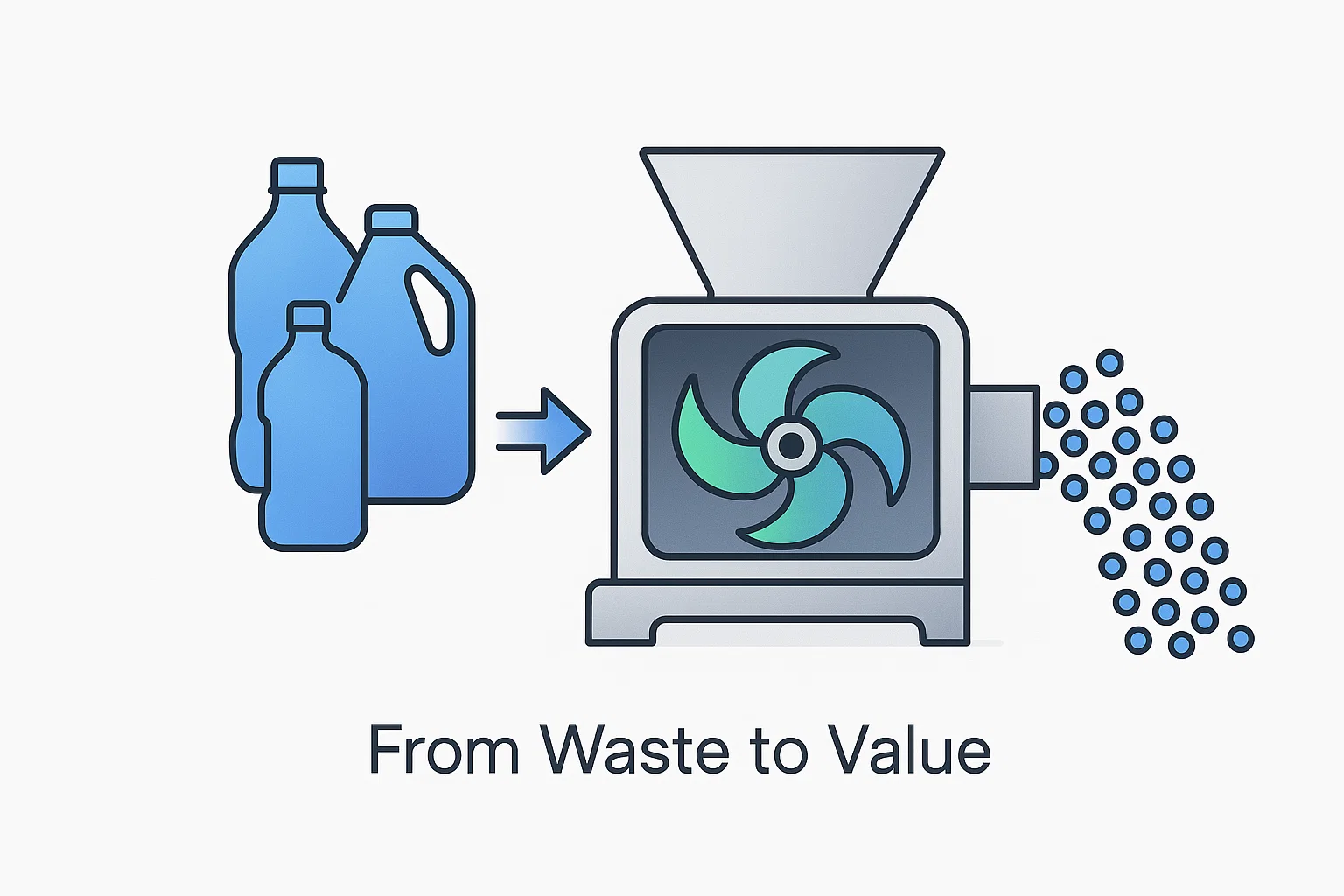플라스틱 재활용의 원동력 해독: 플라스틱 분쇄기의 작동 원리
산업용 플라스틱 재활용 분야에서는 효율성과 정밀성이 무엇보다 중요합니다. 성공적인 재활용 작업의 핵심에는 견고하고 신뢰할 수 있는 기계가 있습니다. 플라스틱 분쇄기플라스틱 폐기물 관리를 최적화하고 폐기물을 귀중한 자원으로 전환하려는 기업이라면, 이 필수 장비의 내부 작동 방식을 이해하는 것이 첫 번째 단계입니다.
Energycle은 최고 수준의 플라스틱 재활용 장비 제공을 전문으로 하며, 고객에게 전문 지식을 제공하고자 합니다. 이 종합 가이드는 플라스틱 분쇄기의 작동 원리, 주요 구성 요소, 그리고 재활용 프로세스에 어떤 혁신을 가져올 수 있는지 자세히 안내해 드립니다.
플라스틱 분쇄기의 기본 역할
플라스틱 분쇄기는 크기 감소를 위해 설계된 강력한 기계입니다. 주요 기능은 불량품, 스프루, 러너, 기타 산업 폐기물과 같은 큰 플라스틱 제품을 "재분쇄물" 또는 "플레이크"라고 불리는 작고 균일한 입자로 분쇄하는 것입니다. 이 공정은 다음과 같은 여러 가지 이유로 매우 중요합니다.
- 취급 및 운반의 용이성: 더 작고 균일한 입자는 부피가 큰 플라스틱 폐기물보다 보관하고 운반하기가 훨씬 쉽습니다.
- 추가 처리를 위한 준비: 과립화기에서 생산된 재분쇄물은 녹여서 새로운 플라스틱 제품으로 재형성할 준비가 되는데, 이는 순환 경제의 핵심 단계입니다.
- 증가된 물질적 가치: 저가치 플라스틱 스크랩을 재사용 가능한 원자재로 변환함으로써 분쇄기는 폐기물 흐름에 상당한 가치를 더해줍니다.
내부 살펴보기: 플라스틱 분쇄기의 핵심 구성 요소
디자인은 다양하지만 대부분의 플라스틱 분쇄기는 효율적인 크기 감소를 달성하기 위해 조화롭게 작동하는 몇 가지 핵심 구성 요소로 이루어져 있습니다.
- 호퍼: 이곳은 플라스틱 폐기물의 유입 지점입니다. 호퍼는 다양한 종류의 플라스틱 재료를 안전하고 쉽게 적재할 수 있도록 설계되었습니다.
- 절단실: 바로 여기서 마법이 일어납니다. 커팅 챔버에는 플라스틱을 파쇄하는 로터와 칼날이 들어 있습니다.
- 로터: 절단실 중앙에는 고속 로터가 있습니다. 로터의 설계는 분쇄기의 성능과 다양한 용도에 대한 적합성을 결정하는 중요한 요소입니다.
- 회전식 칼과 고정식 칼: 로터에는 챔버 하우징에 고정된 고정형 나이프와 함께 작동하는 여러 개의 회전 나이프가 장착되어 있습니다. 이 나이프 세트들 사이의 정밀한 간격은 플라스틱을 효율적으로 절단하는 전단 또는 "가위질" 동작을 생성합니다.
- 화면: 절단실 아래에는 정밀한 크기의 구멍이 뚫린 스크린이 있습니다. 이 스크린은 과립 입자의 최종 크기를 결정합니다. 재료는 스크린을 통과할 만큼 작아질 때까지 절단실에 남아 있습니다.
- 드라이브 시스템: 강력한 모터가 로터를 구동합니다. 모터의 마력은 분쇄기의 처리 능력과 더 단단한 재료 처리 능력을 나타내는 핵심 지표입니다.
- 수집 시스템: 플라스틱이 원하는 크기로 과립화되면 기계에서 배출되는데, 일반적으로 수집통이나 공기 수송 시스템으로 이동하여 재활용 공정의 다음 단계로 운반됩니다.
과립화 프로세스: 단계별 워크플로
이러한 구성 요소가 어떻게 함께 작동하는지 시각화하기 위해 플라스틱 과립화 과정을 간단한 작업 흐름으로 나누어 보겠습니다.
플라스틱 분쇄기 작업 흐름
| 단계 | 행동 | 설명 |
| 1. 인피드 | 플라스틱 폐기물은 호퍼에 투입됩니다. | 이 작업은 수동으로 수행할 수도 있고, 연속 작업을 위해 컨베이어 시스템을 사용할 수도 있습니다. |
| 2. 절단 | 고속 회전자와 칼날이 플라스틱을 자르고 깎기 시작합니다. | 회전 칼과 고정 칼의 상호 작용으로 효율적인 크기 감소가 보장됩니다. |
| 3. 사이징 | 플라스틱은 스크린을 통과할 만큼 작아질 때까지 절단실에 남아 있습니다. | 스크린 크기는 특정 응용 분야에서 원하는 출력 입자 크기에 따라 선택됩니다. |
| 4. 퇴원 | 이제 크기가 균일해진 과립 플라스틱이 기계에서 배출됩니다. | 재분쇄물은 추가 가공이나 판매를 위해 수집됩니다. |
이 연속 사이클은 고품질 플라스틱 재분쇄물의 일관되고 안정적인 생산을 보장합니다. 이 공정을 처리할 수 있는 당사 제립기 유형을 자세히 알아보려면 당사 웹사이트를 방문하세요. 플라스틱 분쇄기 페이지.
성능 및 효율성: 무엇을 찾아야 할까요?
고려할 때 플라스틱 분쇄기 귀하의 시설에 있어서는 몇 가지 성과 지표가 매우 중요합니다.
- 처리량: 이는 분쇄기가 주어진 시간 내에 처리할 수 있는 물질의 양을 나타냅니다(예: kg/시간 또는 lbs/시간).
- 과립 품질: 고품질 과립화기는 먼지나 미립자를 최소화하여 균일한 입자를 생산합니다.
- 에너지 소비량: 최신 분쇄기는 에너지 효율성을 염두에 두고 설계되어 운영 비용을 절감합니다.
- 유지 관리 용이성: 칼을 교체하고 세척할 때 절단실에 쉽게 접근할 수 있는 기능을 찾으세요.
자주 묻는 질문(FAQ)
저희는 산업 기계 투자에 대한 많은 질문을 받으셔야 한다는 것을 잘 알고 있습니다. 고객 여러분께서 가장 많이 문의하시는 내용은 다음과 같습니다.
1. 조립기는 어떤 종류의 플라스틱을 처리할 수 있나요?
당사의 플라스틱 분쇄기는 다음을 포함한 다양한 열가소성 플라스틱을 처리하도록 설계되었습니다.
- 폴리에틸렌(PE) – HDPE, LDPE, LLDPE
- 폴리프로필렌(PP)
- 폴리염화비닐(PVC)
- 폴리에틸렌 테레프탈레이트(PET)
- 폴리스티렌(PS)
- 아크릴로니트릴 부타디엔 스티렌(ABS)1
- 그리고 다른 많은 엔지니어링 등급 플라스틱도 있습니다.
특정 과립화기의 적합성은 재료의 경도, 두께, 형태에 따라 달라집니다.
2. 분쇄기와 과립기의 차이점은 무엇인가요?
둘 다 크기를 줄이는 데 사용되지만 작동 방식은 다릅니다. 파쇄기는 높은 토크와 낮은 속도를 사용하여 크고 부피가 큰 물건을 작고 불규칙한 조각으로 파쇄합니다. 플라스틱 분쇄기반면, 고속 분쇄와 절단 작용을 통해 더 작고 균일한 입자를 생성합니다. 최종 사이징을 위해 재료를 과립기에 투입하기 전에 전처리를 위해 파쇄기를 사용하는 경우가 많습니다.
3. 내 필요에 맞는 올바른 크기의 분쇄기를 어떻게 선택합니까?
적절한 크기의 과립기는 여러 가지 요인에 따라 달라집니다.
- 플라스틱 스크랩의 종류와 양
- 생산량을 유지하는 데 필요한 처리량입니다.
- 원하는 최종 입자 크기.
- 시설 내 사용 가능한 바닥 공간.
Energycle의 팀은 귀하의 특정 요구 사항을 평가하고 귀하의 응용 분야에 가장 적합한 과립기를 추천하는 데 도움을 드립니다.
4. 플라스틱 분쇄기의 유지관리 요구 사항은 무엇입니까?
정기적인 유지관리는 분쇄기의 수명과 최적의 성능을 유지하는 데 중요합니다. 일반적으로 다음이 포함됩니다.
- 정기적으로 칼날을 점검하고 회전시키거나 교체합니다.
- 일관된 입자 크기를 보장하기 위해 화면을 청소합니다.
- 베어링 및 기타 이동 부품에 윤활유를 공급합니다.
- 구동 벨트의 장력과 마모 상태를 검사합니다.
당사는 모든 기계에 대한 포괄적인 유지관리 지침과 지원을 제공합니다.
5. 과립 플라스틱을 내 생산에 재사용할 수 있나요?
물론입니다! 이것이 플라스틱 분쇄기의 주요 장점 중 하나입니다. 생산된 고품질의 균일한 재분쇄물은 종종 원재료와 혼합하여 제조 공정에 다시 투입할 수 있어 상당한 비용 절감과 더욱 지속 가능한 운영으로 이어질 수 있습니다.
투자하다 플라스틱 분쇄기 ~에서 Energycle 귀사의 효율성, 수익성, 그리고 지속가능성에 대한 투자입니다. 이 강력한 기계의 작동 원리를 이해함으로써 향후 수년간 귀사의 운영에 도움이 될 현명한 결정을 내릴 수 있습니다. 더 궁금한 점이 있거나 귀사의 특정 재활용 요구 사항에 대해 상담하고 싶으시면 지금 바로 저희 전문가 팀에 문의해 주세요.



